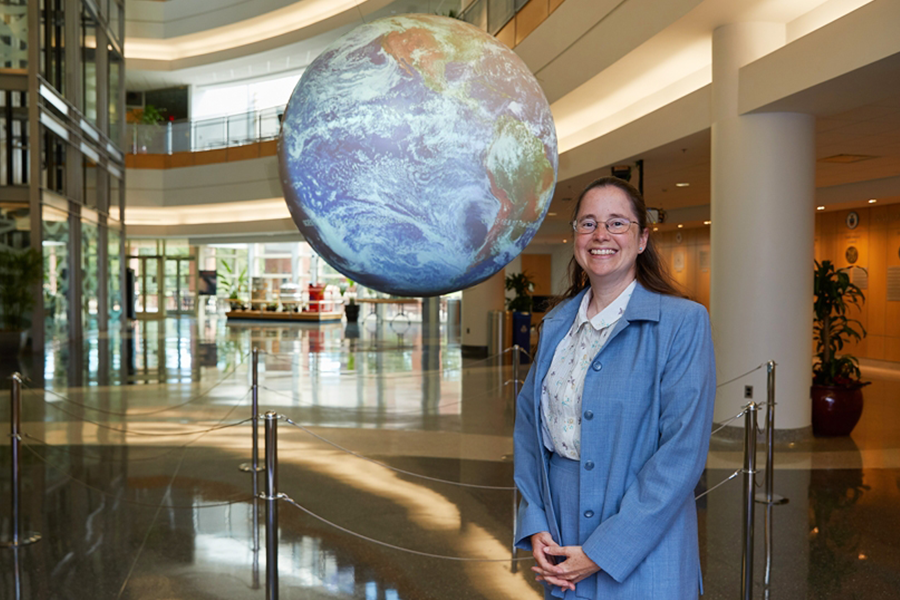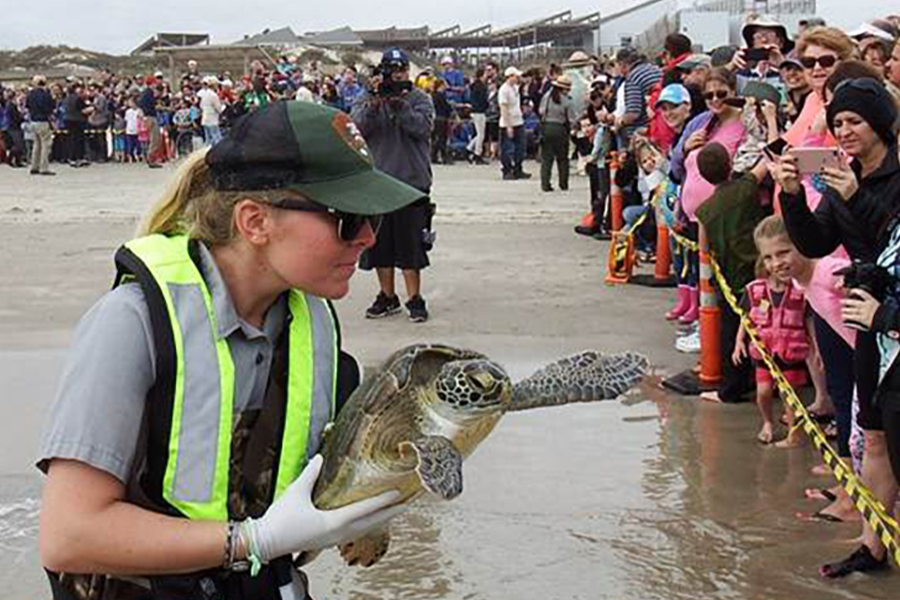 In 2020, University of Oklahoma engineer Amy McGovern, Ph.D., applied for a $20 million grant from the National Science Foundation to establish the AI Institute for Research on Trustworthy AI in Weather, Climate, and Coastal Oceanography. In May of that same year, she was notified that the University of Oklahoma was awarded the grant and that she would be named its director (Photo at left: Amy McGovern)
In 2020, University of Oklahoma engineer Amy McGovern, Ph.D., applied for a $20 million grant from the National Science Foundation to establish the AI Institute for Research on Trustworthy AI in Weather, Climate, and Coastal Oceanography. In May of that same year, she was notified that the University of Oklahoma was awarded the grant and that she would be named its director (Photo at left: Amy McGovern)
Two and a half years later, the institute, AI2ES, has not only formed convergent teams of interdisciplinary researchers but is already making headway in five use-inspired applications: convective weather, winter weather, tropical cyclones, sub-seasonal to seasonal extreme weather, and coastal oceanography (Photo at right: At the Padre Island National Seashore near Corpus Christi, Texas, a park ranger carries a sea turtle to the Gulf of Mexico as part of a cold-stunning release event).
 OU is a national leader in atmospheric research. Much of the early focus at OU for AI2ES has been on the convergence of artificial intelligence, risk communication and convective weather, which refers to thunderstorms, wind, hail, tornadoes and lightning.
OU is a national leader in atmospheric research. Much of the early focus at OU for AI2ES has been on the convergence of artificial intelligence, risk communication and convective weather, which refers to thunderstorms, wind, hail, tornadoes and lightning.
“The artificial intelligence team is working hand-in-hand with atmospheric scientists to develop new AI methods,” said McGovern, the Lloyd G. and Joyce Austin Presidential Professor in the Gallogly College of Engineering and professor in the School of Meteorology. “That work then incorporates social scientists to ensure that our end-users trust the AI we’ve developed and will actually use it.”
Trust is a foundational part of the research AI2ES is undertaking. Understanding the nature of trust, and why some artificial intelligence and automated technologies are trustworthy, and some are not, is vital to the program’s success. Experts and citizens alike need to trust the predictions that AI2ES programs are making.
“This trustworthy work isn’t just about Oklahomans wanting to know when the next thunderstorm is going to happen,” McGovern said. “The benefits of our convective initiation can impact several sectors, including the aviation industry and outdoor events.”
Environmental Prediction
AI2ES is also working on two key applications in Texas: predicting coastal fog and saving endangered sea turtles. By developing artificial intelligence programs to predict coastal fog at the Port of Corpus Christi, one of the nation’s largest seaports, McGovern’s team could potentially mitigate the effects of these weather events and dramatically impact the shipping industry and ports across the United States.
“In Texas, you’re allowed to drive on the beach. But there are endangered turtles that nest right where the trucks drive,” McGovern said. “If we could use AI to detect when the turtles are nesting, we could temporarily stop driving and allow them to lay their eggs. Humans could then collect the eggs and save this endangered species.”
Another application being pursued by the AI2ES team is winter weather research. The University of Albany, a partner of OU, has taken the lead on road weather visibility prediction to determine if roadways are safe for drivers.
“We’re using New York State’s thruway cameras to determine roadway conditions and monitor winter precipitation’s impact on visibility. The AI technology then parses out the data to make predictions about safe driving conditions,” McGovern said. “Hopefully soon we’ll do the same with Oklahoma’s roadway cameras.”
Workforce Development
In addition to the research initiatives, AI2ES is also focusing on education and retraining programs to prepare today’s workers for tomorrow’s jobs. According to the World Economic Forum, approximately 50% of the global workforce will need reskilling by 2050.
“One of our big education initiatives is at our partner institution, Del Mar College in Corpus Christi,” McGovern said. “They’ve developed one of the nation’s first AI occupational skills awards for students to learn new technologies and skills. Their graduates are 80% Hispanic, so we’re also reaching a more diverse population than ever. It’s really exciting.”
Other educational components seeing success are the AI2ES online summer school program aimed at workforce retraining offered in conjunction with the National Oceanic and Atmospheric Administration, the REU internship program offered in conjunction with the National Weather Service and targeted internships with private industry partners.
AI2ES Into the Future
The NSF grant funding for this project runs through 2025. McGovern and the AI2ES team have many goals they hope to achieve during that time, none more important than transferring technologies that save lives and property and better understanding the nature of trust.
“On a more long-term scale, I’m trying to create a multi-agency center that can tackle broader problems for AI and earth science, because I really think there’s so much more that we could do. In particular, we could use AI to improve our resiliency as the climate changes, address environmental justice needs and raise awareness about the need for ethical and responsible AI over the environmental sciences and its earth sciences community,” McGovern said.
Learn more about AI2ES by reading the strategic plan, subscribing to the newsletter, following @ai2enviro on Twitter and watching YouTube videos.
By Josh DeLozier, Office of the Vice President for Research and Partnerships